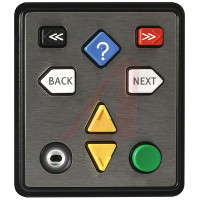EZ08-230013產(chǎn)品概述
Storm Assistive Technology Products provide improved accessibility for those with impaired vision, restricted mobility or limited fine motor skills. Kiosks, ATMs, ticketing machines and voting terminals usually present information about available products and services via a visual display or touch screen. Nav-Pad™ is a highly tactile interface that improves accessibility, making audio navigation and selection of screen based menus possible. An audio description of available menu options is transmitted to the user through a headset, handset or cochlea implant. When the desired menu page or menu option is located it can be selected by the press of a distinctive tactile button.
Successful implementation of the Nav-Pad™ requires a compliant host application featuring synthesized or recorded human voice audio-tags.
Storm Nav-Pad™ keypads are constructed to survive in exposed or hostile outdoor environments and will withstand heavy use and abuse. They are sealed against the ingress of liquids and dust (IP65) to survive regular wash down and sanitation procedures. Nav-Pad™ keypads feature an integral USB interface to ensure hassle free, single cable connection to the host system. (Please note: The USB cable is supplied separately.)
The keypads include an advanced audio processor and illuminated 3.5mm audio jack socket. This to facilitate connection of a headset or handset.
These fully integrated audio equipped keypads enumerate as a combination Advanced Audio and HID Keyboard device, eliminating any requirement for specialized interface software.
Available in 5 key, 6 key and 8 key configurations.
Nav-Pad™ was developed in association with the Trace Research & Development Center with support from the University of Wisconsin. Nav-Pad™ is a compliant tactile interface device for use as part of an ADA audible menu navigation system or EZ-Access® implementation.
In 2016 amendments to ADA regulations will require that automated kiosks meet ‘ ADA Standards for Accessible Design’. To be fully accessible, automated kiosks must be of correct dimensions and physical configuration. Application software must also be accessible and provide support for text to speech capability.


 Datasheet
Datasheet


